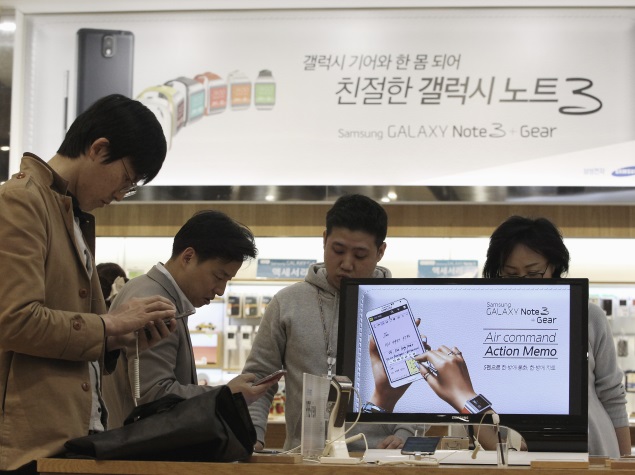- Home
- Mobiles
- Mobiles News
- Samsung Electronics Flags Near 60 Percent Drop in Q3 Operating Profit
Samsung Electronics Flags Near 60 Percent Drop in Q3 Operating Profit

Operating profit for the July-September period was estimated at 4.1 trillion won ($3.8 billion), down 59.6 percent from the third quarter last year, the company said.
Sales were estimated at 47 trillion won, down 20.4 percent from 2013.
While smartphone shipments increased slightly, "operating margin declined due to increased marketing expenditures and a lowered average selling price, driven by reduced proportional shipments of high-end models coupled with price decreases for older smartphone models", the South Korean electronics giant said in an explanatory note.
The company warned that uncertainty in the mobile sector would carry through into the fourth quarter, although it promised a new line-up of top-end smartphones featuring "new materials and innovative designs".
In July, Samsung had reported a 20 percent drop in net profit for the second quarter, and its shares are sitting at a two-year low.
The mobile market, which has been the key driver of Samsung profits in recent years, has become increasingly saturated, while competition has intensified from cheaper Chinese handset makers such as Huawei and Lenovo.
(Also see: Huawei, Lenovo See Huge Gains in Global Smartphone Market Share: IDC)
The world's largest smartphone maker has a diverse product line ranging from memory chips to home appliances, but more than half of its profits are generated by mobile devices.
The explanatory note said shipments and profits in the company's display panel business had also fallen in the third quarter due to weaker demand in the mobile sector.
It did not provide a breakdown of profit estimates by businesses.
A double hit
Samsung's smartphone profits have been hit at both ends of the spectrum.
Its previously all-conquering flagship Galaxy S series has come under renewed pressure with the release of the popular iPhone 6 from arch-rival Apple, which has also challenged Samsung's dominance of the oversized smartphone market with the introduction of the larger-screen iPhone 6 Plus.
In the low- to mid-range smartphone segment, the challenge has come from Chinese handset makers who have begun to make substantial inroads into Samsung's market share.
According to IDC, a record-high 295.3 million smartphones were shipped worldwide in the second quarter.
Samsung remained the world's top vendor, moving 74 million handsets, but saw its overall market share slip seven percentage points to 25.2 percent, while China's Huawei nearly doubled its shipments from the same quarter a year ago.
Samsung said Tuesday it would bring out a new series of mid- to low-end smartphones in the fourth quarter "with strong competitive positioning on both hardware specifications and price".
Last month, Samsung brought forward the launch of its oversized Galaxy Note 4 smartphone and got it into Chinese and South Korean stores ahead of its sale in 140 other countries.
It was the first time a flagship Samsung product had gone on sale in China ahead of other markets.
"We are temporarily going through a difficult business situation," Lee Don-Joo, head of sales and marketing for Samsung's mobile unit, told reporters at the Note 4 launch.
For the latest tech news and reviews, follow Gadgets 360 on X, Facebook, WhatsApp, Threads and Google News. For the latest videos on gadgets and tech, subscribe to our YouTube channel. If you want to know everything about top influencers, follow our in-house Who'sThat360 on Instagram and YouTube.
Related Stories
- Samsung Galaxy Unpacked 2025
- ChatGPT
- Redmi Note 14 Pro+
- iPhone 16
- Apple Vision Pro
- Oneplus 12
- OnePlus Nord CE 3 Lite 5G
- iPhone 13
- Xiaomi 14 Pro
- Oppo Find N3
- Tecno Spark Go (2023)
- Realme V30
- Best Phones Under 25000
- Samsung Galaxy S24 Series
- Cryptocurrency
- iQoo 12
- Samsung Galaxy S24 Ultra
- Giottus
- Samsung Galaxy Z Flip 5
- Apple 'Scary Fast'
- Housefull 5
- GoPro Hero 12 Black Review
- Invincible Season 2
- JioGlass
- HD Ready TV
- Laptop Under 50000
- Smartwatch Under 10000
- Latest Mobile Phones
- Compare Phones
- Moto G15 Power
- Moto G15
- Realme 14x 5G
- Poco M7 Pro 5G
- Poco C75 5G
- Vivo Y300 (China)
- HMD Arc
- Lava Blaze Duo 5G
- Asus Zenbook S 14
- MacBook Pro 16-inch (M4 Max, 2024)
- Honor Pad V9
- Tecno Megapad 11
- Redmi Watch 5
- Huawei Watch Ultimate Design
- Sony 65 Inches Ultra HD (4K) LED Smart TV (KD-65X74L)
- TCL 55 Inches Ultra HD (4K) LED Smart TV (55C61B)
- Sony PlayStation 5 Pro
- Sony PlayStation 5 Slim Digital Edition
- Blue Star 1.5 Ton 3 Star Inverter Split AC (IC318DNUHC)
- Blue Star 1.5 Ton 3 Star Inverter Split AC (IA318VKU)

















